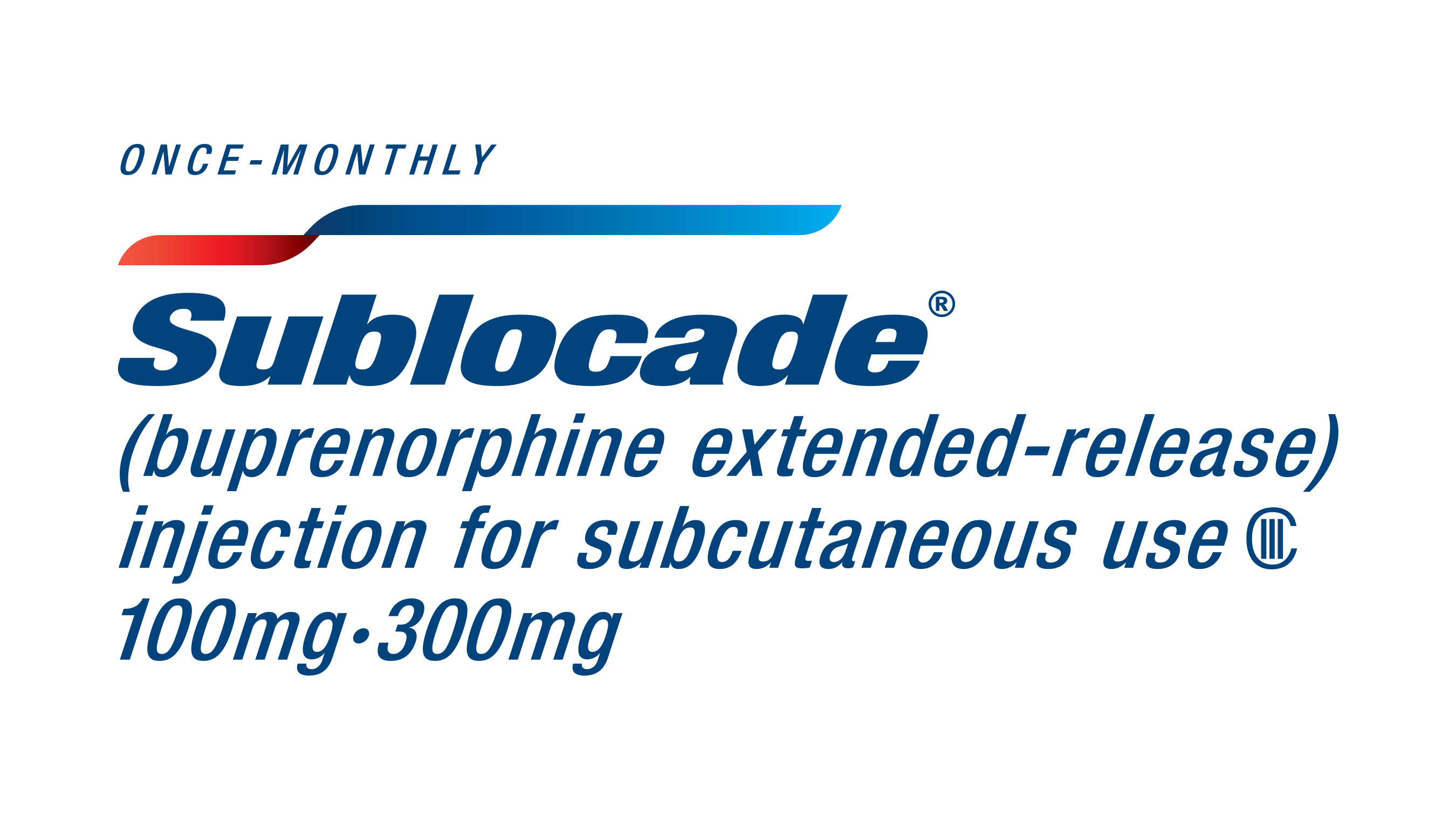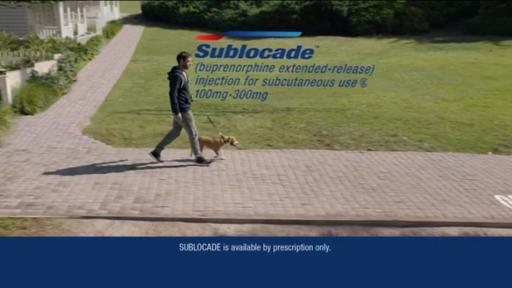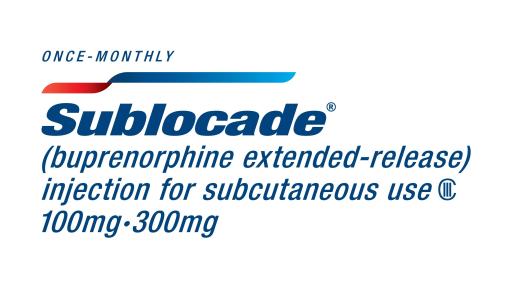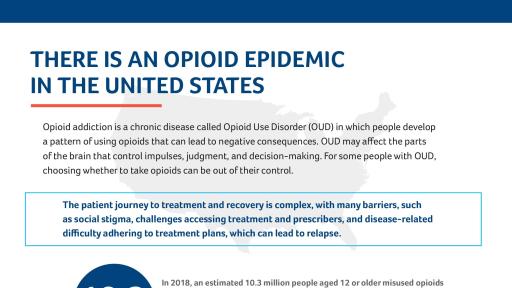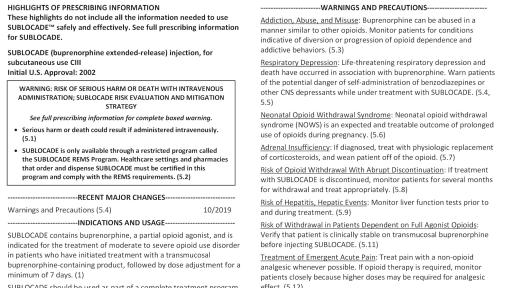Indivior Launches National Campaign Informing People of an Additional Treatment for Opioid Use Disorder (OUD) and to Let People with OUD Know That They Can
“Keep Moving Towards Recovery”
—Only 20% of people suffering from the disease receive any kind of treatment—
Richmond, VA, November 11, 2019 – Indivior PLC (LON: INDV) announces the launch of a new direct-to-consumer (DTC) advertising campaign, Keep Moving Towards Recovery, which aims to heighten awareness of treatment with SUBLOCADE® (buprenorphine extended-release) injection, for subcutaneous use (CIII), as well as motivate those with moderate to severe opioid use disorder (OUD) and those who care about them to seek help from health care professionals to keep moving towards recovery. SUBLOCADE is a prescription medicine used to treat adults with moderate to severe addiction (dependence) to opioid drugs (prescription or illegal) who have received an oral transmucosal (used under the tongue or inside the cheek) buprenorphine-containing medicine at a dose that controls withdrawal symptoms for at least 7 days. SUBLOCADE is part of a complete treatment plan that should include counseling.1
The Keep Moving Towards Recovery campaign is intended to help reframe the perceptions of those struggling with moderate to severe opioid addiction. Opioid addiction isn’t a moral weakness, it is a chronic disease called Opioid Use Disorder (OUD)2 in which people develop a pattern of using opioids that can lead to negative consequences.3 OUD may affect the parts of the brain that control impulses, judgment, and decision-making.3,4 Patients become trapped in a cycle of opioid use, withdrawal, and cravings, which produces changes in brain function that can reduce their ability to control their use.3,5
“Although the medical community has recognized that opioid addiction is a chronic disease, many people with OUD are still not receiving appropriate, evidence-based therapies,” said Gary Mendell, Founder and CEO of Shatterproof. “Closing this gap and ensuring that people impacted have access to the combination of counseling and medication for the addiction treatment that is best for them is critical to reversing the tragic trends across the country.”
Medication-assisted treatment (MAT) combines medication and counseling to treat both the physical and behavioral parts of opioid addiction, with the goal of helping people achieve and maintain recovery.3,4 The combination of medicine and psychosocial therapy have been proven successful in treating OUD and can even help extend recovery.3,4 In fact, MAT has been shown to be more effective than either medication or counseling alone.4
“While the Keep Moving Towards Recovery DTC campaign is anticipated to help raise awareness of treatment with SUBLOCADE, we also hope this campaign will contribute to the broader effort underway to help people suffering from OUD to know that medication, including counseling, is available to help them treat their addiction and help them keep moving towards recovery,” said Shaun Thaxter, Chief Executive Officer of Indivior. “We believe that those suffering from moderate to severe opioid use disorder, and their loved ones who are indirectly affected by this disease, should be aware of all available treatment options so that they may discuss with their treatment provider the appropriate option for them.”
A common misconception about medications used to treat OUD is that some of the medicines used simply substitute one drug for another.6,7,8 However, these medications may restore healthy brain function, which leads to improvements in behaviors associated with addiction. Longer-term use of these medications is associated with improved outcomes.9
Buprenorphine – which is one kind of medicine used to treat OUD – has been shown to reduce craving, which can be one of the drivers for continued opiate use.6,7,8 In a clinical study, SUBLOCADE patients were 14x more likely to achieve treatment success – 28% of people with SUBLOCADE plus counseling compared to 2% of people with placebo plus counseling.1 In a 24-week study, treatment success was defined as opioid-free at least 80% of the weeks in treatment. Opioid-free means urine sample tested negative for illicit opioids plus no self-reported use of opioids. Weeks were not always consecutive.1
“Despite robust evidence that medicines to treat OUD are safe and effective,9 only 20% of people suffering from OUD receive any kind of treatment2,” said Mark Greenwald, Ph.D., Director, Substance Abuse Research Division, Department of Psychiatry and Behavioral Neurosciences, Wayne State University. “This startling statistic highlights the need for more education about evidence-based treatments for OUD that can help people more effectively treat their illness and achieve recovery.”
Every patient journey is different. Patients with moderate to severe OUD should talk to their doctors to determine whether medication-assisted treatment with SUBLOCADE is the right treatment option for them. To learn more about different medications and different treatment program directories and resources in their area, people can visit the Substance Abuse and Mental Health Service www.samhsa.gov. People can also visit www.inSupport.com to locate certified SUBLOCADE providers in or near their community.
To view the direct-to-consumer (DTC) campaign, Keep Moving Towards Recovery, please click here or visit www.sublocade.com.
About SUBLOCADE
SUBLOCADE (buprenorphine extended-release) injection, for subcutaneous use (CIII) is a prescription medicine used to treat adults with moderate to severe addiction (dependence) to opioid drugs (prescription or illegal) who have received an oral transmucosal (used under the tongue or inside the cheek) buprenorphine-containing medicine at a dose that controls withdrawal symptoms for at least 7 days. SUBLOCADE is part of a complete treatment plan that should include counseling.1
The overall safety profile for SUBLOCADE, given by a healthcare provider in clinical trials, was consistent with the known safety profile of transmucosal buprenorphine, except for injection site reactions.1 Adverse reactions commonly associated with SUBLOCADE (in ≥5% of subjects) were constipation, headache, nausea, injection site pruritus, vomiting, increased hepatic enzymes, fatigue and injection site pain. Injection site reactions were reported in 16.5% of patients in Phase 3 studies.1 Most of the injection site adverse reactions (ADRs) were of mild to moderate severity.1 None of the injection site reactions were serious, and one led to study treatment discontinuation.1 SUBLOCADE has a BOXED WARNING and is available through restricted distribution under the SUBLOCADE Risk Evaluation and Mitigation Strategy (REMS) Program.1 Pursuant to the SUBLOCADE REMS, all healthcare settings and pharmacies that order and dispense SUBLOCADE must be certified and establish processes and procedures to verify the medication is dispensed directly to a healthcare provider for administration by a healthcare provider and is not dispensed directly to the patient.1 Moreover, certified healthcare settings and pharmacies must not distribute, transfer, loan or sell SUBLOCADE.1
INDICATION AND USAGE
SUBLOCADE is indicated for the treatment of moderate to severe opioid use disorder in patients who have initiated treatment with a transmucosal buprenorphine-containing product followed by a dose adjustment period for a minimum of seven days.
SUBLOCADE should be used as part of a complete treatment program that includes counseling and psychosocial support.
IMPORTANT SAFETY INFORMATION
Prescription use of this product is limited under the Drug Addiction Treatment Act.
WARNING: RISK OF SERIOUS HARM OR DEATH WITH INTRAVENOUS ADMINISTRATION; SUBLOCADE RISK EVALUATION AND MITIGATION STRATEGY
- Serious harm or death could result if administered intravenously. SUBLOCADE forms a solid mass upon contact with body fluids and may cause occlusion, local tissue damage, and thrombo-embolic events, including life threatening pulmonary emboli, if administered intravenously.
- Because of the risk of serious harm or death that could result from intravenous self-administration, SUBLOCADE is only available through a restricted program called the SUBLOCADE REMS Program. Healthcare settings and pharmacies that order and dispense SUBLOCADE must be certified in this program and comply with the REMS requirements.
CONTRAINDICATIONS
SUBLOCADE should not be administered to patients who have been shown to be hypersensitive to buprenorphine or any component of the ATRIGEL® delivery system.
WARNINGS AND PRECAUTIONS
Addiction, Abuse, and Misuse: SUBLOCADE contains buprenorphine, a Schedule III controlled substance that can be abused in a manner similar to other opioids. Monitor patients for conditions indicative of diversion or progression of opioid dependence and addictive behaviors.
Respiratory Depression: Life threatening respiratory depression and death have occurred in association with buprenorphine. Warn patients of the potential danger of self-administration of benzodiazepines or other CNS depressants while under treatment with SUBLOCADE.
Neonatal Opioid Withdrawal Syndrome: Neonatal opioid withdrawal syndrome is an expected and treatable outcome of prolonged use of opioids during pregnancy.
Adrenal Insufficiency: If diagnosed, treat with physiologic replacement of corticosteroids, and wean patient off of the opioid.
Risk of Opioid Withdrawal with Abrupt Discontinuation: If treatment with SUBLOCADE is discontinued, monitor patients for several months for withdrawal and treat appropriately.
Risk of Hepatitis, Hepatic Events: Monitor liver function tests prior to and during treatment.
Risk of Withdrawal in Patients Dependent on Full Agonist Opioids: Verify that patient is clinically stable on transmucosal buprenorphine before injecting SUBLOCADE.
Treatment of Emergent Acute Pain: Treat pain with a non-opioid analgesic whenever possible. If opioid therapy is required, monitor patients closely because higher doses may be required for analgesic effect.
ADVERSE REACTIONS
Adverse reactions commonly associated with SUBLOCADE (in ≥5% of subjects) were constipation, headache, nausea, injection site pruritus, vomiting, increased hepatic enzymes, fatigue, and injection site pain.
For further product information, see full Prescribing Information including BOXED WARNING and Medication Guide at www.SUBLOCADE.com.
About Opioid Use Disorder (OUD)
Opioid addiction isn’t a moral weakness. Opioid addiction is a chronic disease called Opioid Use Disorder (OUD)2 in which people develop a pattern of using opioids that can lead to negative consequences.3 Opioid addiction may affect the parts of the brain that control impulses, judgment, and decision-making.3,4 Patients become trapped in a cycle of opioid use, withdrawal, and cravings, which produces changes in brain function that can reduce their ability to control their use.3,5
In 2018, an estimated 10.3 million people aged 12 or older misused opioids in the past year, including 9.9 million prescription pain reliever misusers and 808,000 heroin users. Approximately 506,000 people misused prescription pain relievers and used heroin in the past year.10 SUBLOCADE is not indicated for use in children younger than 18 years of age. Buprenorphine, the active ingredient of SUBLOCADE can cause severe, possibly fatal, respiratory depression in children who are accidentally exposed to it.1
About Indivior
Indivior is a global pharmaceutical company working to help change patients’ lives by developing medicines to treat addiction and serious mental illnesses. Our vision is that all patients around the world will have access to evidence-based treatment for the chronic conditions and co-occurring disorders of addiction. Indivior is dedicated to transforming addiction from a global human crisis to a recognized and treated chronic disease.
Building on its global portfolio of opioid dependence treatments, Indivior has a pipeline of product candidates designed to both expand on its heritage in this category and address other chronic conditions and co-occurring disorders of addiction, including alcohol use disorder. Headquartered in the United States in Richmond, VA, Indivior employs more than 800 individuals globally and its portfolio of products is available in over 40 countries worldwide. Visit www.indivior.com to learn more. Connect with Indivior on LinkedIn by visiting www.linkedin.com/company/indivior.
Forward-Looking Statements
This press release contains certain statements that are forward-looking and which should be considered, amongst other statutory provisions, in light of the safe harbor provisions of the United States Private Securities Litigation Reform Act of 1995. By their nature, forward-looking statements involve risk and uncertainty as they relate to events or circumstances that may or may not occur in the future. Actual results may differ materially from those expressed or implied in such statements because they relate to future events. Forward-looking statements include, among other things, statements regarding the Indivior Group’s financial guidance for 2019 and its medium- and long-term growth outlook, its operational goals, its product development pipeline and statements regarding ongoing litigation. Various factors may cause differences between Indivior's expectations and actual results, including: factors affecting sales of Indivior Group’s products; the outcome of research and development activities; decisions by regulatory authorities regarding the Indivior Group’s drug applications; the speed with which regulatory authorizations, pricing approvals and product launches may be achieved; the outcome of post-approval clinical trials; competitive developments; difficulties or delays in manufacturing; the impact of existing and future legislation and regulatory provisions on product exclusivity; trends toward managed care and healthcare cost containment; legislation or regulatory action affecting pharmaceutical product pricing, reimbursement or access; claims and concerns that may arise regarding the safety or efficacy of the Indivior Group’s products and product candidates; risks related to legal proceedings, including the ongoing investigative and antitrust litigation matters; the Indivior Group’s ability to protect its patents and other intellectual property; the outcome of patent infringement litigation relating to Indivior Group’s products, including the ongoing ANDA lawsuits; changes in governmental laws and regulations; issues related to the outsourcing of certain operational and staff functions to third parties; uncertainties related to general economic, political, business, industry, regulatory and market conditions; and the impact of acquisitions, divestitures, restructurings, internal reorganizations, product recalls and withdrawals and other unusual items. This press release does not constitute an offer to sell or the solicitation of an offer to subscribe for or otherwise acquire or dispose of shares in the Company to any person in any jurisdiction to whom it is unlawful to make such offer or solicitation.
Media Contacts
US
[email protected]
+1 804-594-0836
UK
Tulchan Communications
+44 207-353-4200
Investor Contact
Jason Thompson
Indivior Vice President, Investor Relations
+1 804-379-1033
[email protected]
References
- SUBLOCADE® [Prescribing Information]. Indivior Inc., North Chesterfield, VA. October 2019.
- U.S. Department of Health and Human Services (HHS), Office of the Surgeon General. Facing Addiction in America: The Surgeon General’s Report on Alcohol, Drugs, and Health. Washington, DC: HHS, November 2016.
- U.S. Department of Health and Human (HHS), Services Substance Abuse and Mental Health Services Administration Center for Substance Abuse Treatment (SAMHSA). Medication-Assisted Treatment for Opioid Addiction. HHS Publication No. (SMA) 09-4443, First printed 2009. Revised 2011.
- U.S. Department of Health and Human Services (HHS), National Institute on Drug Abuse, National Institutes of Health. Drugs, Brains, and Behavior: The Science of Addiction. HHS Publication No. (SMA) 18-5063PT5, Printed 2018.
- Volkow ND, Koob GF, McLellan AT. Neurobiologic advances from the brain disease model of addiction. N Engl J Med. 2016;374:363-371.
- U.S. Department of Health and Human (HHS), Services Substance Abuse and Mental Health Services Administration Center for Substance Abuse Treatment (SAMHSA). Tip 63: Medications for Opioid Use Disorder. HHS Publication No. (SMA) 18-5063PT1, Printed 2018
- U.S. Department of Health and Human Services (HHS), National Institute on Drug Abuse, National Institutes of Health. Medications to Treat Opioid Use Disorder. Retrieved from: https://www.drugabuse.gov/publications/research-reports/medications-to-treat-opioid-addiction/how-do-medications-to-treat-opioid-addiction-work. Accessed on November 5, 2019.
- U.S. Department of Health and Human Services (HHS), National Institute on Drug Abuse, National Institutes of Health. Effective Treatments for Opioid Addiction. November 2016.
- National Academies of Sciences, Engineering, and Medicine. 2019. Medications for Opioid Use Disorder Save Lives. Washington, DC: The National Academies Press. http://doi.org/10.17226/25310.
- Substance Abuse and Mental Health Services Administration. Key substance use and mental health indicators in the United States: Results from the 2018 National Survey on Drug Use and Health. HHS Publication No. PEP19-5068, NSDUH Series H-54. Rockville, MD: Center for Behavioral Health Statistics and Quality, Substance Abuse and Mental Health Services Administration. Retrieved from https://www.samhsa.gov/data/. Accessed on November 7, 2019.

